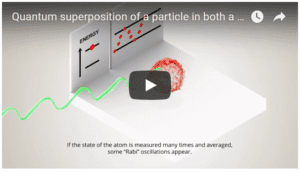(Also called “quantum decoherence.”) Decoherence occurs when a quantum particle loses its coherence. So, what is coherence? When a quantum particle is coherent, it acts wavelike and displays properties that people consider to be quantum weirdness, as described below. In contrast, when decoherent, a quantum particle is detected as a particle. It becomes an ordinary particle that follows the laws of classical electromagnetism and other classical physics laws. It doesn’t display quantum weirdness. Decoherence is the physical meaning often assigned to the collapse of the wave function.

More on Coherence
Quantum coherence is a property of a quantum particle. When we say that a quantum particle is coherent, we are saying that it is in its quantum state. In its quantum state, a particle is in a superposition of many states. In its coherent state, a quantum particle acts like a strange set of waves. It behaves in accordance with the Schrodinger Equation and:
• In the two-slit experiment, can form an interference pattern;
• Follows the Heisenberg Uncertainty Principle;
- Can perform quantum tunneling;
• If entangled with another particle, correlates its behavior instantaneously with its entangled partner, regardless of distance; and
• Displays other forms of quantum weirdness.
In other words, coherent particles are quantum particles which are following the laws of quantum mechanics. For example, a photon experiencing coherence might, at the same moment, be in Position A, B, and C. Let’s say that Position C is smack in the middle of the retina of a frog. Further, let’s say that, at a certain moment during the night, the photon travels to Position C—it hits the retina of the frog and is absorbed by an electron in the retina. So, the photon has lost its superposition and, for a brief moment, occupies Position C. In that moment, it has decohered.

Macroscopic objects cannot maintain the quantum coherence of their particles. Their particles are close together and interact with each other and with things in the environment like air molecules. Interaction causes their particles to lose their quantum states and reduce themselves to occupying single states. Macroscopic objects, having particles that have decohered, do not follow the laws of quantum mechanics. They follow the laws of classical physics.
Not all interactions of quantum particles result in decoherence. When no physical universe energy transfers from one particle to another, a particle interaction does not precipitate decoherence. For example, interactions of particles with virtual particles often do not precipitate decoherence.
Decoherence and Collapse of the Wave Function
The Schrodinger Equation, published in 1926, provides a mathematical description of the behavior of coherent quantum particles. It also calculates the probabilities that the particle, when detected, will have chosen any particular property among the possibilities. In the example of the photon, above, the Schrodinger Equation would be used to calculate the probabilities of the particle being detected in Position A, Position B, or Position C. When the photon decoheres and is detected in Position C, this is called the “collapse of the wave function.”
Decoherence and Quantum Computers
Quantum computers rely upon a quantum particle, perhaps an electron or an atom, which is in a superposition. But upon interaction with other particles, a quantum particle loses its superposition. It decoheres. The key to developing quantum computers is isolating quantum particles so that they retain their superpositions as long as possible. This is done by keeping the electron or atom in a vacuum and/or keeping it extremely cold.
In some experiments on quantum computerization, an atom has been isolated in an ultra-high vacuum chamber which has allowed the atom to retain its superposition for over 10 minutes. The atom is trapped in the vacuum chamber by, for example, magnetic fields, so that it doesn’t interact with the walls of the chamber. The air within the chamber is pumped out, and the air pressure is brought down to 100 trillion times lower than atmospheric pressure. At this strength of a vacuum, an air molecule would typically travel a distance equivalent to the circumference of the Earth before bumping into another air molecule! This is in sharp contrast to the density of air molecules at ordinary atmospheric pressure. At ordinary atmospheric pressure, so many gas molecules float around that the atom need travel only the width of a human hair before bumping into a nearby molecule. Physicists continue to develop techniques for lengthening the decoherence time of quantum particles, a key to progress in quantum computing.
It should be noted, however, that it is not only particles of matter like molecules of air that might cause interaction and decoherence, the cosmic microwave background radiation can also cause decoherence, and that is always present no matter what steps to isolate the atom are taken.
Decoherence and Interpretations of Quantum Physics
The original interpretation of quantum mechanics, the Copenhagen Interpretation of the 1920’s, does not include the concept of decoherence. Instead, it maintains that an understanding of physics does not require that physical meaning be assigned to the collapse of the wave function. The concept of decoherence was initially developed in the 1950’s and has been under development since. The concept of decoherence is an integral part of the Many Worlds interpretation of quantum mechanics. It has also been included as part of a number of other interpretations, including, in modern times, even the Copenhagen Interpretation.
As a theory, decoherence is expressed mathematically and is among the mathematical theories of quantum mechanics. A detailed mathematical description of decoherence gets quite technical and is beyond my understanding. As a note, a simpler understanding of the collapse of the wave function is available in the Transactional Interpretation of quantum mechanics.
